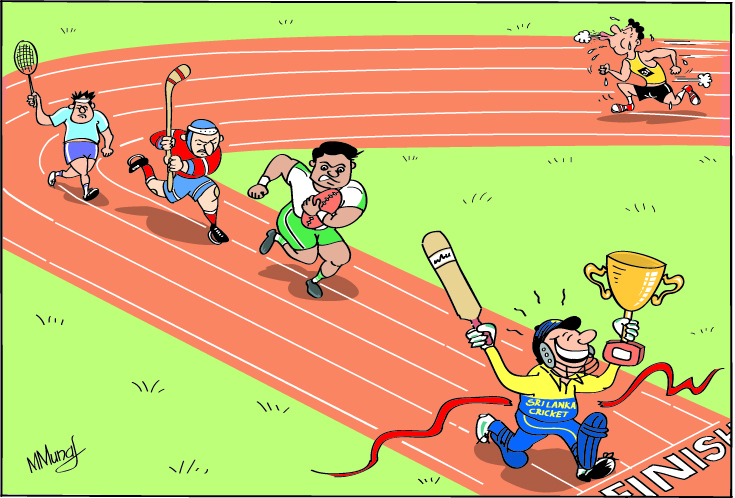Lessons from Incheon
View(s):Some years ago I was at Isipathana College on a weekday, chatting up with a teacher during the school interval. Something that I noticed at that point never left my memory.
Down the school yard several little boys were running in motion. While on the trot, they were passing an object that looked like a shoe, but in reality they were working the three-quarter line in imaginary rugby, yet the move had cohesion and rhythm. I just thought to myself this is how legends were born. I wonder as to what their names were and how many of them played for their school and thereafter.
The significance in that scenario is what prompted those young ones mimic a rugby match in motion. It probably came from the traditions that the school had embedded in the imagination of the students. With the achievements of their peers the following generations of Isipathana know that they are the next phase of that tradition; it is they who will have to the real thing someday, out on the field. So for now passing an old shoe and running down the school yard would be sufficient.
Intriguingly two sports have really captured the imagination of schoolboys in Sri Lanka. First is cricket. It came to the country as a missionary/military legacy of the colonialists through the elite schools, but, soon it broke the barriers and spread into other schools as well. But within the past half century it has travelled from shore to shore – North to South and East to West.
Rugby also entered the Lankan schools during the same period in our history and in the same manner. However, the sport stopped short of bursting its seams although some schools like Isipathana became huge disciples of this recreation.
There is another significant feature. The game of hockey became almost a home base in Matale, but, nurturing a sport to develop into national fantasy could not be built up from one single town.
 It was only last week that the chief of the National Cricket Selection Committee Sanath Jayasuriya was beaming. He was elated that the game of cricket had to come to the rescue of the Lankan pride and bring home an Asian Cup gold after twelve long years. Incidentally the other medal that came Lanka’s way was a bronze and that too was won by Sri Lanka’s female cricketers.
It was only last week that the chief of the National Cricket Selection Committee Sanath Jayasuriya was beaming. He was elated that the game of cricket had to come to the rescue of the Lankan pride and bring home an Asian Cup gold after twelve long years. Incidentally the other medal that came Lanka’s way was a bronze and that too was won by Sri Lanka’s female cricketers.
Though rugby is doing relatively well in the Asian circuit, our ruggerites failed to win a medal, in spite of coming very close.
What about the rest of the gang. They just failed. We ask why?
Besides the gold and the bronze, the Lankans did come into the limelight in Incheon. Two of the participants – Wasantha Ratnapala, a member of the beach Volleyball team and Prasanna Dissanayake, a member of the hockey, team disappeared. Thanks to their short-sighted and selfish action, Sri Lanka’s image has been further tarnished. The repercussion of their action will be that in future all Sri Lankan athletes will be subjected to suspicion and humiliation at airports and visa counters at foreign missions.
Besides, within the last ten years, there have been more Lankan athletes who have had to take a dive for dabbling with banned substances than the ones who have really brought back a legitimate accolade.
Take athletics. It was not so long ago that Sri Lanka produced a stream of athletes in the calibre of Susanthika Jayasinghe, Damayanthi Dharsha, Sugath Tillekeratne, Sriyani Kulawansa and Sriyantha Dissanayake. They not only shone at Asian level but, even in the European circuit and Olympics. But, after they drew the curtains, it was the screen coming down on Sri Lanka.
It is an accepted fact that the Lankans genetically are sports-oriented and they do possess the wherewithal to surface, if the right background is provided.
In Asian countries like China, South Korea and Japan million dollar projects are mooted to produce athletes who will win medals. But, Susanthika Jayasinghe who had only a fraction of the facilities that the athletes of China, Korea and Japan enjoy, won an Olympic Silver in a sprint event – a forte that was kept among the athletes in the West of Ankara.
Intrigued by this proposition, the musings inquired from one of those people who were directly responsible for discovering that plethora of Lankan performers: How did they all come to the limelight within the space of a few years.
Sunil Jayaweera was the director of sports at the Ministry of Education from the mid-eighties till the mid-nineties and during this era, the National School Games was a big event.
Jayaweera explained, “We had no special formula or a magic portion. During the 1984-1994 era, we picked all athletes who came through the schools system and at that time we had S.B. Dissanayake as the Sports Minister – a person who had been an athlete himself.
“So we generated this system where the athletes who came out of the schools system, did not run blind in the post-schools era. There were programmes and they were nurtured and at one juncture Sri Lankan athletics was at a very sound footing.”
Jayaweera said there were active athletic clubs like the CT and FC, the Trackmasters, Aces and Sri Lak Athletic Club besides the three forces. This meant the competition was stiff and the athletes had something to strive for and standards to maintain, he opined.
Jayaweera pointed out that these clubs were either defunct or maintaining a low profile. As a result, he said there was no input to the national grid. Now the only solace is the security forces, but, their focus is a bit different to a national perspective. At the same time he was thankful that athletics, courtesy the forces, were being sustained though the clubs had failed.
Jayaweera explained: “You don’t have to draw up huge programmes at once. We can get the districts up and running with a focused programme and get each of these units come up on their own with sponsorships and employment programmes. This is where the Ministry of Sports comes into the centre stage. This is where they have to draw up the programmes and take the onus. They have to take the responsibility.
“The forces will absorb a percentage of the athletes coming from the schools arena, but they cannot support a huge contingent. This is what cricket and rugby have provided. They have given the rural youth the hope that they could sustain themselves by being in the sport even if they do not reach the national standards. In cricket, there are numerous clubs and the club base is very strong. So the intake to the national grid from the forces in cricket is minimal.
“In rugby, the forces are strong. But at the same time the impact from clubs like Kandy SC, Havelocks Sports Club, the CR and FC is also strong and as a result the game is on a good footing.”
This is where the other sports have failed. The administrators cannot provide the hope and belief to the next generation about their future and security.
That is why countries like China and Japan moot nationwide programmes and lure the young athletes towards sports. Those programmes are professional and foolproof.
We too must build trust and hope in the future athletes with a vision. Till then they will only jump the gun to defame the country. No hope… no gold.


